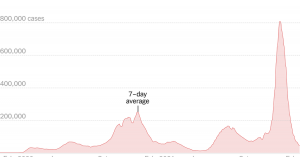
[ad_1]
WELLINGTON, New Zealand — In an historic grove in northern New Zealand, the mighty conifer acknowledged as Tāne Mahuta, lord of the forest, is threatened by the encroachment of a fatal enemy.
It is the premier kauri tree regarded to be dwelling: 177 ft tall, 53 toes in circumference. Kauri, native to New Zealand, are between the world’s longest-residing trees, and Tāne Mahuta has been developing in Waipoua Forest for about 2,000 decades — more time than New Zealand has been inhabited by people. It is named after the god of forests in Māori mythology, who is stated to have pushed apart the sky father and the earth mother to create space for existence to prosper.
But Tāne Mahuta stands just 200 feet from a further kauri whose roots are contaminated with an incurable disease. Kauri dieback, induced by a microscopic, fungus-like organism, has arrived at pandemic proportions and driven an already threatened species closer to extinction. Nearby, 5 other kauri are also contaminated.
Given the age and dimensions of kauri, quite a few Māori view them as distant ancestors. Tāne Mahuta is notably unique to some, for the relationship to the Māori generation tale. “The threat of kauri dieback to the species is a danger to Māori id by itself,” reported Taoho Patuawa, main science officer for the neighborhood Māori tribe, Te Roroa.
That tribe and others are racing to safeguard the remaining kauri ahead of it’s as well late. Just after extra than a decade of federal government inaction and patchy scientific investigation, Māori have taken a guide on conservation endeavours, hoping to invest in time for enhancement of a get rid of.
Kauri dieback, identified in 2006, spreads as a result of the motion of infested soil, typically by using mud on footwear. At the time close to a kauri, the disease’s spores infect its roots, causing them to rot. The disorder can infect other plant everyday living, but it is significantly devastating to kauri.
When it reaches the trunk, lesions crack out. Kauri begin to bleed yellow, pus-like gum in an endeavor to cover their sides in thick armor. But it is by now far too late. The pathogen corrodes the internal tissues that carry vitamins and water, in essence starving the tree to demise. When kauri die, so does a lot of the surrounding plant everyday living that depends on it.
Injecting phosphite can slow the development of the sickness, but there is no heal.
In 2017, New Zealand’s forestry minister at the time, Shane Jones, described the government’s kauri dieback reaction up to that point as “an unmitigated catastrophe.” Experts predicted that the species, which at the time covered thousands and thousands of acres in New Zealand, would go extinct inside of 3 a long time.
Māori scientists, who are often extra related to the communities influenced by kauri dieback, have disproportionately been the kinds contacting for action. Melanie Mark-Shadbolt, an environmental sociologist, mentioned the authorities experienced not taken kauri dieback, or Māori concerns about it, very seriously. The government’s biodiversity security process, she said, “doesn’t deliver for Māori at all.”
Nick Waipara, a scientist who specializes in kauri dieback, said that the aggressive method for scientific funding had directed funds toward the priorities of non-Māori scientists.
For a decade, he said, get the job done on the disease was “problematic, underfunded, piecemeal and advert hoc.”
The lag had devastating outcomes. “I’ve found with my individual eyes, when we have been performing long-term monitoring of plots, spots where by in some several years we haven’t discovered a single seedling that was alive,” Dr. Waipara claimed.
Snow Tane, the normal supervisor of the Te Roroa Progress Team, claimed that all-around 2015 the tribe commenced to notice that not only did kauri dieback pose an great danger to the forests of New Zealand, but that minor assistance was on the way.
“We could have waited for some thing to materialize, or we could have started the ball rolling ourselves,” Mr. Tane claimed.
So the tribe stationed kauri ambassadors on tracks and close to the forest’s entrances to reveal to people the significance of the trees and make certain nobody strayed way too close to them. The tribe had previously worked with New Zealand’s Section of Conservation to put in a boardwalk close to Tāne Mahuta to avert site visitors from spreading infected soil around its roots. In 2018, immediately after camera surveillance confirmed dozens of people have been however evading ambassadors and leaving the observe to get closer to its trunk, guardrails went up far too.
The election of a centre-remaining govt in 2017 also supplied a strengthen. The new biodiversity minister, Damien O’Connor, pushed by way of stronger government guidelines on kauri dieback. In accordance to Dr. Waipara and Ms. Mark-Shadbolt, this prompted the bodies that fund scientific research to choose a lot more desire in kauri options.
Stuart Anderson, the deputy director-typical for biosecurity in the Ministry of Principal Industries, explained the company was committed to working with Māori and observed that of the 8 million New Zealand pounds ($5.3 million) it will invest on kauri dieback this 12 months, 50 % will go right to Māori teams.
Even these steps, although, appeared insufficient to struggle the sickness. So the Te Roroa tribe went further more, exercising its authority as custodians of Waipoua Forest to near several of its going for walks tracks entirely. When the govt imposed Covid-19 lockdowns in 2020, Te Roroa took the chance to impose a rāhui, or short term prohibition on entry, above the complete forest.
These limitations induced controversy. Dr. Waipara explained that forest managers and scientists he realized had been violently threatened by folks who oppose restrictions, or even deny the disease’s existence.
He as opposed it to the backlash in opposition to attempts to contain Covid-19. “There’s similar concerns, worry, threats, denials and fairly horrific actions by some people,” he said.
Nonetheless, checking carried out by Te Roroa indicated that the restrictions have been doing work. In accordance to Mr. Patuawa, Te Roroa’s chief science officer, they ended up only dealing with “pockets of infected trees in decrease.” Te Roroa was adequately pleased to elevate its rāhui over Waipoua Forest later in 2020.
Mr. Patuawa cautioned that would adjust if kauri dieback spread closer to Tāne Mahuta and other vital kauri.
“New Zealand wants to fall the feeling of entitlement that we have to be anywhere we want to be,” he claimed. “We have to have to be a little bit additional sensitive to these attractive destinations.”
But, for now, there’s hope among advocates that Māori-led interventions have created sufficient time for scientists to preserve the kauri. And even with the risk that Tāne Mahuta faces, Dr. Waipara mentioned, “I assume he is in quite great hands.”
[ad_2]
Supply url



